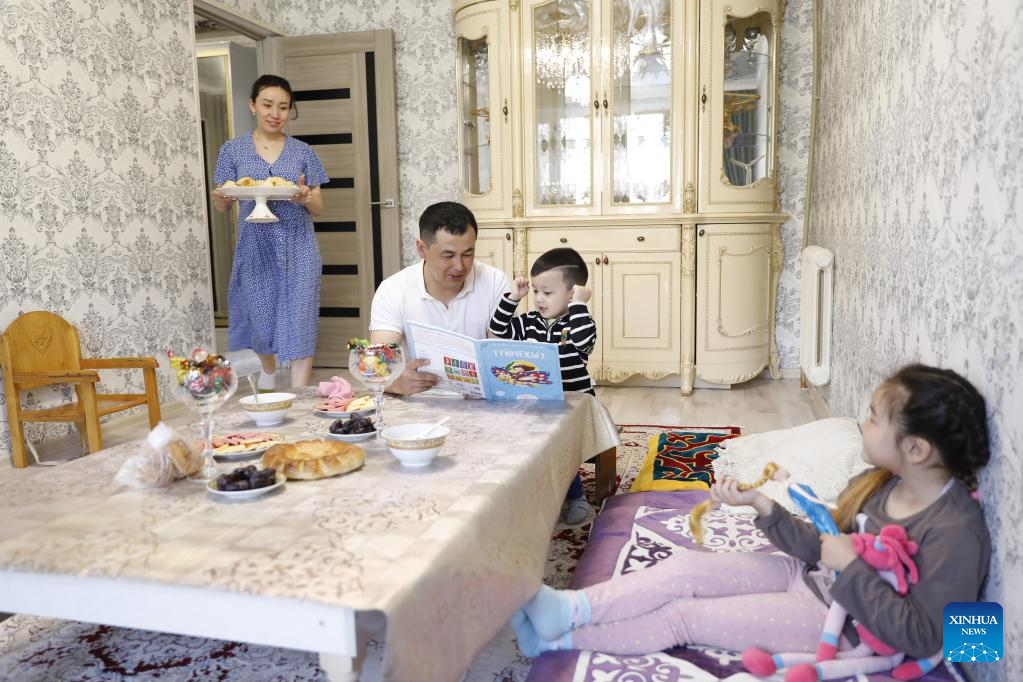
Maksat Abilgaziev (2nd L) is pictured with his family in Zhanatas, Kazakhstan, on April 3, 2023. China and Kazakhstan are pioneers in production capacity and investment cooperation, under the framework of the synergy between the Belt and Road Initiative and Kazakhstan's "Bright Road" new economic policy. The cooperation list includes 52 projects worth a total of more than 21.2 billion U.S. dollars.
The 100-MW Zhanatas wind farm is one of the first batch of key energy projects under the China-Kazakhstan production capacity cooperation framework.
The project was put into operation in June 2021, becoming Central Asia's largest wind farm at that time, greatly alleviating the power shortage in southern Kazakhstan.
Maksat Abilgaziev, a resident of Zhanatas, had been an electrical engineer at a local phosphate mine company. He said he was impressed by the turbine, as its 60-meter-long blade covers an area as big as the London Eye observation wheel, adding that the wind blows in his hometown most of the year. He believed the future of his homeland and Kazakhstan lies in clean energy, especially wind energy. So in 2020, the 30-year-old man decided to step out of his comfort zone and embrace "the future." He then became a trainee responsible for maintaining and repairing wind turbines at the Zhanatas wind farm and learned related maintenance work from Chinese experts.
This year is the third year for Abilgaziev to work at the wind farm. Diligence and studiousness has made the Kazakh man a senior maintenance engineer. "I have a stable job and my life has become better," he said. He and his pregnant wife are looking forward to the fifth member of their family.
The wind power project has created jobs and increased tax revenue for his hometown, bringing new opportunities for urban development, said Abilgaziev.
Talking about the prospect of green energy cooperation between China and Central Asia, Abilgaziev said he was confident that the sky will be bluer, the water cleaner and that human beings will live on a more beautiful Earth in the future. (Photo by Kalizhan Ospanov/Xinhua)

Maksat Abilgaziev (R) and his colleague work inside a wind turbine generator in Zhanatas, Kazakhstan, on April 3, 2023. China and Kazakhstan are pioneers in production capacity and investment cooperation, under the framework of the synergy between the Belt and Road Initiative and Kazakhstan's "Bright Road" new economic policy. The cooperation list includes 52 projects worth a total of more than 21.2 billion U.S. dollars.
The 100-MW Zhanatas wind farm is one of the first batch of key energy projects under the China-Kazakhstan production capacity cooperation framework.
The project was put into operation in June 2021, becoming Central Asia's largest wind farm at that time, greatly alleviating the power shortage in southern Kazakhstan.
Maksat Abilgaziev, a resident of Zhanatas, had been an electrical engineer at a local phosphate mine company. He said he was impressed by the turbine, as its 60-meter-long blade covers an area as big as the London Eye observation wheel, adding that the wind blows in his hometown most of the year. He believed the future of his homeland and Kazakhstan lies in clean energy, especially wind energy. So in 2020, the 30-year-old man decided to step out of his comfort zone and embrace "the future." He then became a trainee responsible for maintaining and repairing wind turbines at the Zhanatas wind farm and learned related maintenance work from Chinese experts.
This year is the third year for Abilgaziev to work at the wind farm. Diligence and studiousness has made the Kazakh man a senior maintenance engineer. "I have a stable job and my life has become better," he said. He and his pregnant wife are looking forward to the fifth member of their family.
The wind power project has created jobs and increased tax revenue for his hometown, bringing new opportunities for urban development, said Abilgaziev.
Talking about the prospect of green energy cooperation between China and Central Asia, Abilgaziev said he was confident that the sky will be bluer, the water cleaner and that human beings will live on a more beautiful Earth in the future. (Photo by Kalizhan Ospanov/Xinhua)
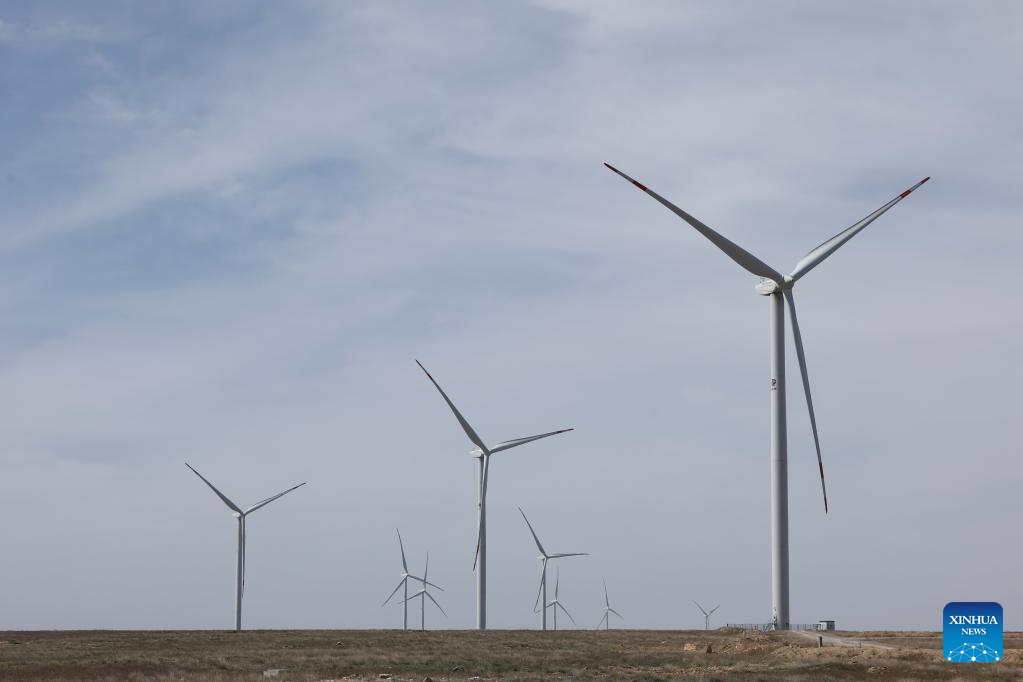
This photo taken on April 3, 2023 shows some wind turbine generators of the 100-MW Zhanatas wind farm in Zhanatas, Kazakhstan. China and Kazakhstan are pioneers in production capacity and investment cooperation, under the framework of the synergy between the Belt and Road Initiative and Kazakhstan's "Bright Road" new economic policy. The cooperation list includes 52 projects worth a total of more than 21.2 billion U.S. dollars.
The 100-MW Zhanatas wind farm is one of the first batch of key energy projects under the China-Kazakhstan production capacity cooperation framework.
The project was put into operation in June 2021, becoming Central Asia's largest wind farm at that time, greatly alleviating the power shortage in southern Kazakhstan.
Maksat Abilgaziev, a resident of Zhanatas, had been an electrical engineer at a local phosphate mine company. He said he was impressed by the turbine, as its 60-meter-long blade covers an area as big as the London Eye observation wheel, adding that the wind blows in his hometown most of the year. He believed the future of his homeland and Kazakhstan lies in clean energy, especially wind energy. So in 2020, the 30-year-old man decided to step out of his comfort zone and embrace "the future." He then became a trainee responsible for maintaining and repairing wind turbines at the Zhanatas wind farm and learned related maintenance work from Chinese experts.
This year is the third year for Abilgaziev to work at the wind farm. Diligence and studiousness has made the Kazakh man a senior maintenance engineer. "I have a stable job and my life has become better," he said. He and his pregnant wife are looking forward to the fifth member of their family.
The wind power project has created jobs and increased tax revenue for his hometown, bringing new opportunities for urban development, said Abilgaziev.
Talking about the prospect of green energy cooperation between China and Central Asia, Abilgaziev said he was confident that the sky will be bluer, the water cleaner and that human beings will live on a more beautiful Earth in the future. (Photo by Kalizhan Ospanov/Xinhua)
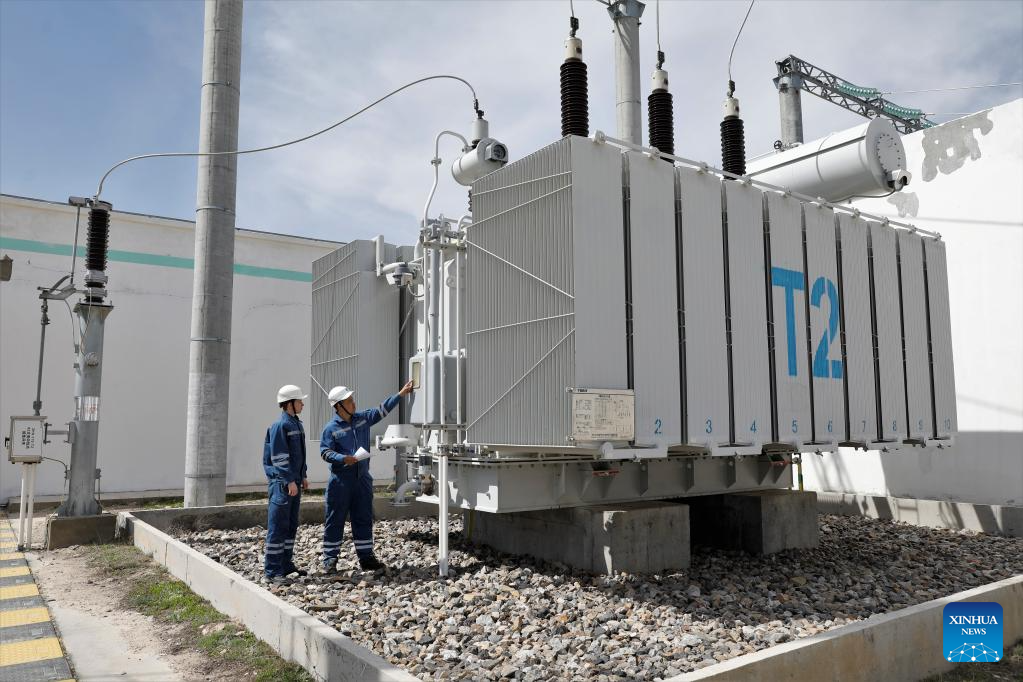
Maksat Abilgaziev (R) and his colleague check power transformer equipment at Zhanatas wind farm in Zhanatas, Kazakhstan, on April 3, 2023. China and Kazakhstan are pioneers in production capacity and investment cooperation, under the framework of the synergy between the Belt and Road Initiative and Kazakhstan's "Bright Road" new economic policy. The cooperation list includes 52 projects worth a total of more than 21.2 billion U.S. dollars.
The 100-MW Zhanatas wind farm is one of the first batch of key energy projects under the China-Kazakhstan production capacity cooperation framework.
The project was put into operation in June 2021, becoming Central Asia's largest wind farm at that time, greatly alleviating the power shortage in southern Kazakhstan.
Maksat Abilgaziev, a resident of Zhanatas, had been an electrical engineer at a local phosphate mine company. He said he was impressed by the turbine, as its 60-meter-long blade covers an area as big as the London Eye observation wheel, adding that the wind blows in his hometown most of the year. He believed the future of his homeland and Kazakhstan lies in clean energy, especially wind energy. So in 2020, the 30-year-old man decided to step out of his comfort zone and embrace "the future." He then became a trainee responsible for maintaining and repairing wind turbines at the Zhanatas wind farm and learned related maintenance work from Chinese experts.
This year is the third year for Abilgaziev to work at the wind farm. Diligence and studiousness has made the Kazakh man a senior maintenance engineer. "I have a stable job and my life has become better," he said. He and his pregnant wife are looking forward to the fifth member of their family.
The wind power project has created jobs and increased tax revenue for his hometown, bringing new opportunities for urban development, said Abilgaziev.
Talking about the prospect of green energy cooperation between China and Central Asia, Abilgaziev said he was confident that the sky will be bluer, the water cleaner and that human beings will live on a more beautiful Earth in the future. (Photo by Kalizhan Ospanov/Xinhua)
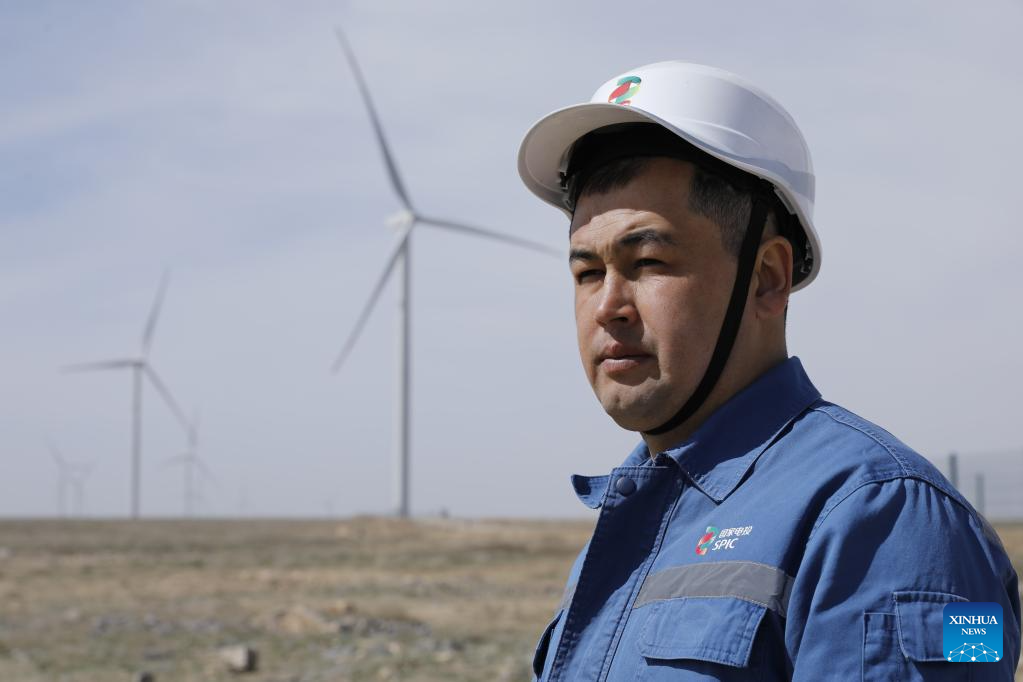
Maksat Abilgaziev is pictured in front of wind turbine generators in Zhanatas, Kazakhstan, on April 3, 2023. China and Kazakhstan are pioneers in production capacity and investment cooperation, under the framework of the synergy between the Belt and Road Initiative and Kazakhstan's "Bright Road" new economic policy. The cooperation list includes 52 projects worth a total of more than 21.2 billion U.S. dollars.
The 100-MW Zhanatas wind farm is one of the first batch of key energy projects under the China-Kazakhstan production capacity cooperation framework.
The project was put into operation in June 2021, becoming Central Asia's largest wind farm at that time, greatly alleviating the power shortage in southern Kazakhstan.
Maksat Abilgaziev, a resident of Zhanatas, had been an electrical engineer at a local phosphate mine company. He said he was impressed by the turbine, as its 60-meter-long blade covers an area as big as the London Eye observation wheel, adding that the wind blows in his hometown most of the year. He believed the future of his homeland and Kazakhstan lies in clean energy, especially wind energy. So in 2020, the 30-year-old man decided to step out of his comfort zone and embrace "the future." He then became a trainee responsible for maintaining and repairing wind turbines at the Zhanatas wind farm and learned related maintenance work from Chinese experts.
This year is the third year for Abilgaziev to work at the wind farm. Diligence and studiousness has made the Kazakh man a senior maintenance engineer. "I have a stable job and my life has become better," he said. He and his pregnant wife are looking forward to the fifth member of their family.
The wind power project has created jobs and increased tax revenue for his hometown, bringing new opportunities for urban development, said Abilgaziev.
Talking about the prospect of green energy cooperation between China and Central Asia, Abilgaziev said he was confident that the sky will be bluer, the water cleaner and that human beings will live on a more beautiful Earth in the future. (Photo by Kalizhan Ospanov/Xinhua)
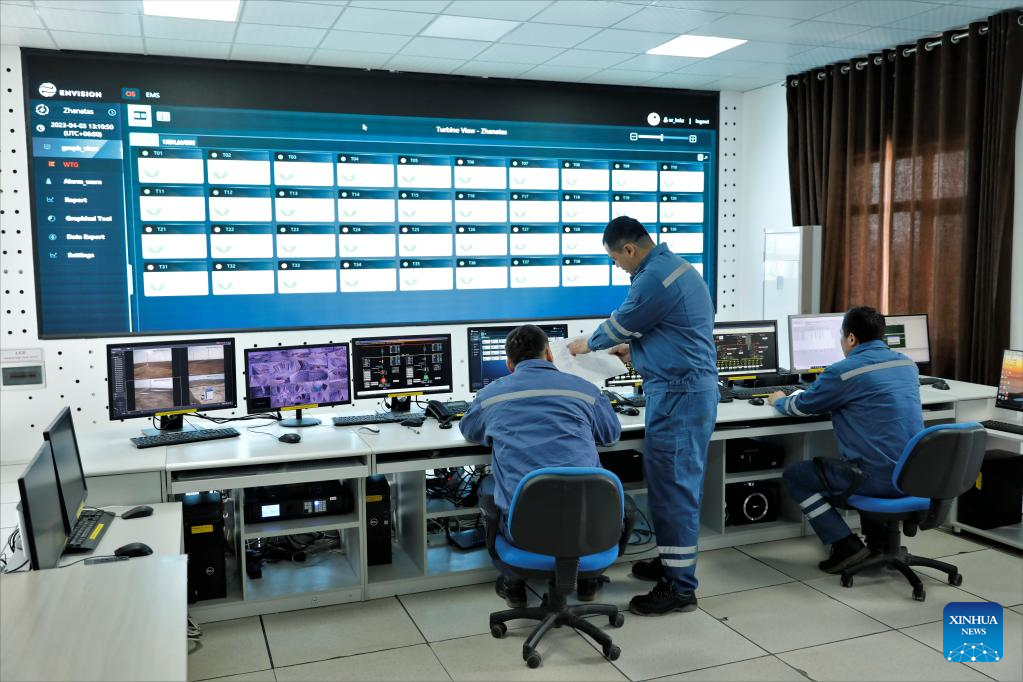
Maksat Abilgaziev (C) works at the central control room of a wind power project in Zhanatas, Kazakhstan, on April 3, 2023. China and Kazakhstan are pioneers in production capacity and investment cooperation, under the framework of the synergy between the Belt and Road Initiative and Kazakhstan's "Bright Road" new economic policy. The cooperation list includes 52 projects worth a total of more than 21.2 billion U.S. dollars.
The 100-MW Zhanatas wind farm is one of the first batch of key energy projects under the China-Kazakhstan production capacity cooperation framework.
The project was put into operation in June 2021, becoming Central Asia's largest wind farm at that time, greatly alleviating the power shortage in southern Kazakhstan.
Maksat Abilgaziev, a resident of Zhanatas, had been an electrical engineer at a local phosphate mine company. He said he was impressed by the turbine, as its 60-meter-long blade covers an area as big as the London Eye observation wheel, adding that the wind blows in his hometown most of the year. He believed the future of his homeland and Kazakhstan lies in clean energy, especially wind energy. So in 2020, the 30-year-old man decided to step out of his comfort zone and embrace "the future." He then became a trainee responsible for maintaining and repairing wind turbines at the Zhanatas wind farm and learned related maintenance work from Chinese experts.
This year is the third year for Abilgaziev to work at the wind farm. Diligence and studiousness has made the Kazakh man a senior maintenance engineer. "I have a stable job and my life has become better," he said. He and his pregnant wife are looking forward to the fifth member of their family.
The wind power project has created jobs and increased tax revenue for his hometown, bringing new opportunities for urban development, said Abilgaziev.
Talking about the prospect of green energy cooperation between China and Central Asia, Abilgaziev said he was confident that the sky will be bluer, the water cleaner and that human beings will live on a more beautiful Earth in the future. (Photo by Kalizhan Ospanov/Xinhua)

Maksat Abilgaziev (C) works at the central control room of a wind power project in Zhanatas, Kazakhstan, on April 3, 2023. China and Kazakhstan are pioneers in production capacity and investment cooperation, under the framework of the synergy between the Belt and Road Initiative and Kazakhstan's "Bright Road" new economic policy. The cooperation list includes 52 projects worth a total of more than 21.2 billion U.S. dollars.
The 100-MW Zhanatas wind farm is one of the first batch of key energy projects under the China-Kazakhstan production capacity cooperation framework.
The project was put into operation in June 2021, becoming Central Asia's largest wind farm at that time, greatly alleviating the power shortage in southern Kazakhstan.
Maksat Abilgaziev, a resident of Zhanatas, had been an electrical engineer at a local phosphate mine company. He said he was impressed by the turbine, as its 60-meter-long blade covers an area as big as the London Eye observation wheel, adding that the wind blows in his hometown most of the year. He believed the future of his homeland and Kazakhstan lies in clean energy, especially wind energy. So in 2020, the 30-year-old man decided to step out of his comfort zone and embrace "the future." He then became a trainee responsible for maintaining and repairing wind turbines at the Zhanatas wind farm and learned related maintenance work from Chinese experts.
This year is the third year for Abilgaziev to work at the wind farm. Diligence and studiousness has made the Kazakh man a senior maintenance engineer. "I have a stable job and my life has become better," he said. He and his pregnant wife are looking forward to the fifth member of their family.
The wind power project has created jobs and increased tax revenue for his hometown, bringing new opportunities for urban development, said Abilgaziev.
Talking about the prospect of green energy cooperation between China and Central Asia, Abilgaziev said he was confident that the sky will be bluer, the water cleaner and that human beings will live on a more beautiful Earth in the future. (Photo by Kalizhan Ospanov/Xinhua)
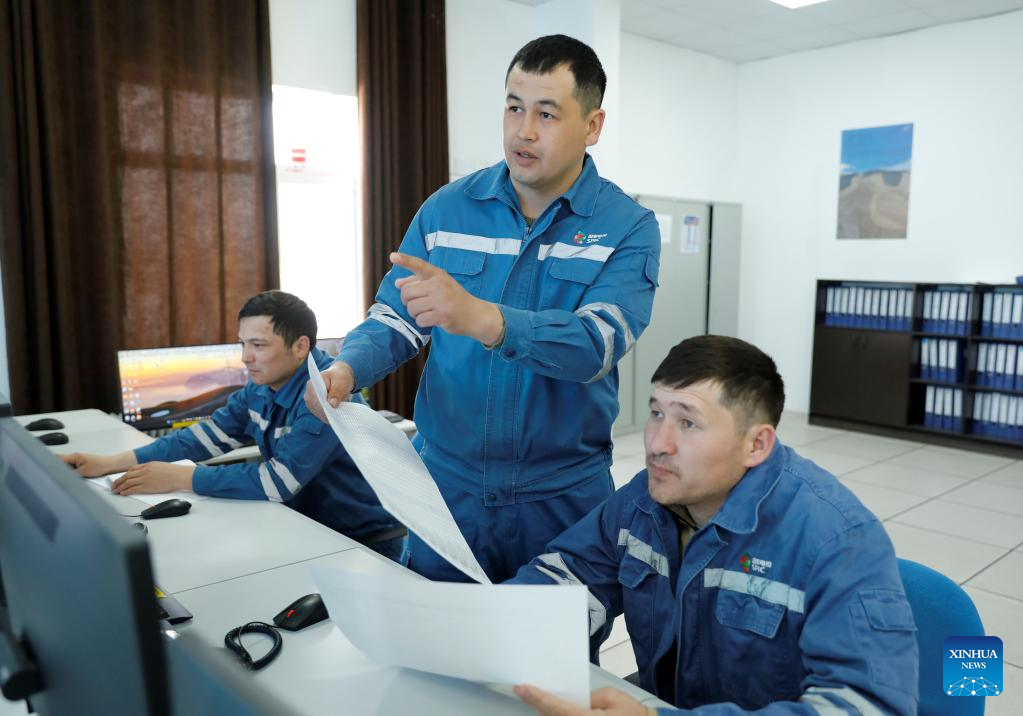
Maksat Abilgaziev (C) works at the central control room of a wind power project in Zhanatas, Kazakhstan, on April 3, 2023. China and Kazakhstan are pioneers in production capacity and investment cooperation, under the framework of the synergy between the Belt and Road Initiative and Kazakhstan's "Bright Road" new economic policy. The cooperation list includes 52 projects worth a total of more than 21.2 billion U.S. dollars.
The 100-MW Zhanatas wind farm is one of the first batch of key energy projects under the China-Kazakhstan production capacity cooperation framework.
The project was put into operation in June 2021, becoming Central Asia's largest wind farm at that time, greatly alleviating the power shortage in southern Kazakhstan.
Maksat Abilgaziev, a resident of Zhanatas, had been an electrical engineer at a local phosphate mine company. He said he was impressed by the turbine, as its 60-meter-long blade covers an area as big as the London Eye observation wheel, adding that the wind blows in his hometown most of the year. He believed the future of his homeland and Kazakhstan lies in clean energy, especially wind energy. So in 2020, the 30-year-old man decided to step out of his comfort zone and embrace "the future." He then became a trainee responsible for maintaining and repairing wind turbines at the Zhanatas wind farm and learned related maintenance work from Chinese experts.
This year is the third year for Abilgaziev to work at the wind farm. Diligence and studiousness has made the Kazakh man a senior maintenance engineer. "I have a stable job and my life has become better," he said. He and his pregnant wife are looking forward to the fifth member of their family.
The wind power project has created jobs and increased tax revenue for his hometown, bringing new opportunities for urban development, said Abilgaziev.
Talking about the prospect of green energy cooperation between China and Central Asia, Abilgaziev said he was confident that the sky will be bluer, the water cleaner and that human beings will live on a more beautiful Earth in the future. (Photo by Kalizhan Ospanov/Xinhua)
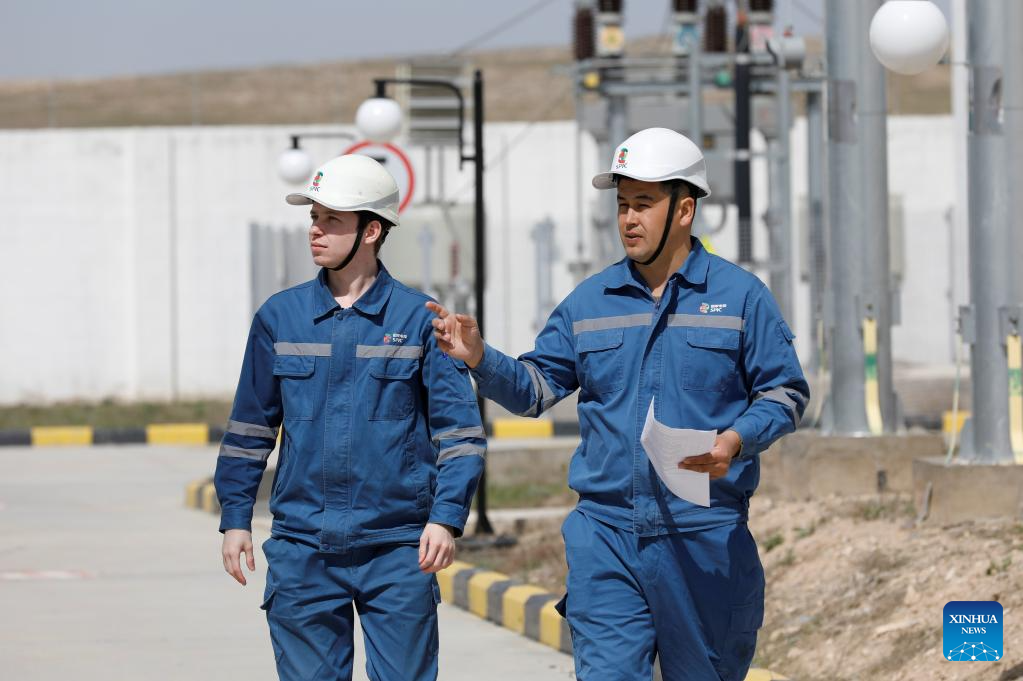
Maksat Abilgaziev (R) and his colleague check power transformer equipment at Zhanatas wind farm in Zhanatas, Kazakhstan, on April 3, 2023. China and Kazakhstan are pioneers in production capacity and investment cooperation, under the framework of the synergy between the Belt and Road Initiative and Kazakhstan's "Bright Road" new economic policy. The cooperation list includes 52 projects worth a total of more than 21.2 billion U.S. dollars.
The 100-MW Zhanatas wind farm is one of the first batch of key energy projects under the China-Kazakhstan production capacity cooperation framework.
The project was put into operation in June 2021, becoming Central Asia's largest wind farm at that time, greatly alleviating the power shortage in southern Kazakhstan.
Maksat Abilgaziev, a resident of Zhanatas, had been an electrical engineer at a local phosphate mine company. He said he was impressed by the turbine, as its 60-meter-long blade covers an area as big as the London Eye observation wheel, adding that the wind blows in his hometown most of the year. He believed the future of his homeland and Kazakhstan lies in clean energy, especially wind energy. So in 2020, the 30-year-old man decided to step out of his comfort zone and embrace "the future." He then became a trainee responsible for maintaining and repairing wind turbines at the Zhanatas wind farm and learned related maintenance work from Chinese experts.
This year is the third year for Abilgaziev to work at the wind farm. Diligence and studiousness has made the Kazakh man a senior maintenance engineer. "I have a stable job and my life has become better," he said. He and his pregnant wife are looking forward to the fifth member of their family.
The wind power project has created jobs and increased tax revenue for his hometown, bringing new opportunities for urban development, said Abilgaziev.
Talking about the prospect of green energy cooperation between China and Central Asia, Abilgaziev said he was confident that the sky will be bluer, the water cleaner and that human beings will live on a more beautiful Earth in the future. (Photo by Kalizhan Ospanov/Xinhua)
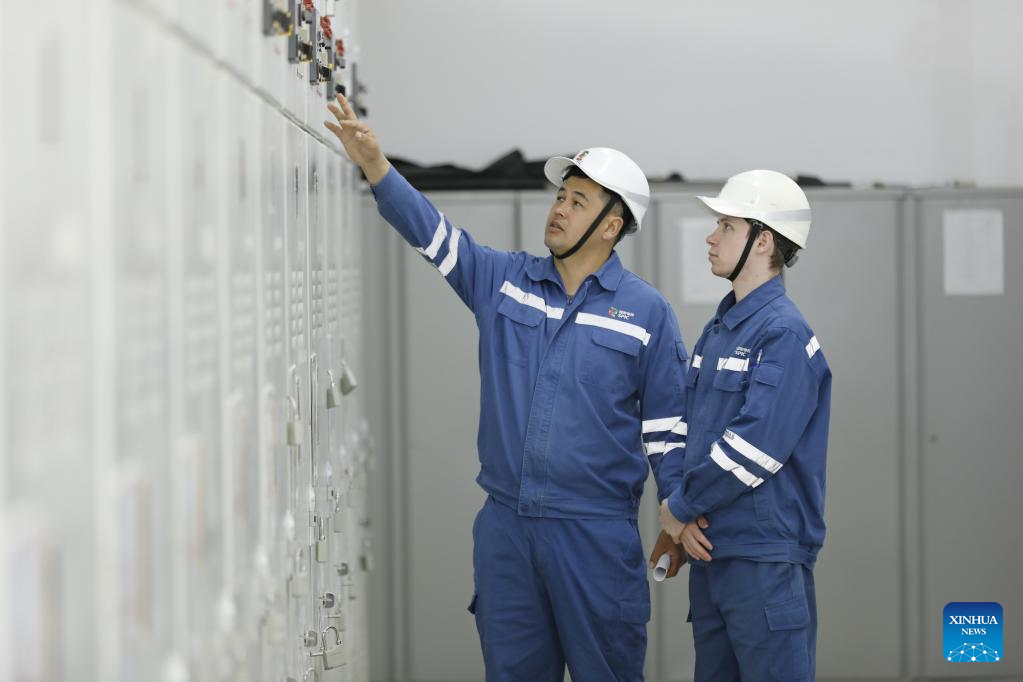
Maksat Abilgaziev (L) and his colleague check power distribution equipment at Zhanatas wind farm in Zhanatas, Kazakhstan, on April 3, 2023. China and Kazakhstan are pioneers in production capacity and investment cooperation, under the framework of the synergy between the Belt and Road Initiative and Kazakhstan's "Bright Road" new economic policy. The cooperation list includes 52 projects worth a total of more than 21.2 billion U.S. dollars.
The 100-MW Zhanatas wind farm is one of the first batch of key energy projects under the China-Kazakhstan production capacity cooperation framework.
The project was put into operation in June 2021, becoming Central Asia's largest wind farm at that time, greatly alleviating the power shortage in southern Kazakhstan.
Maksat Abilgaziev, a resident of Zhanatas, had been an electrical engineer at a local phosphate mine company. He said he was impressed by the turbine, as its 60-meter-long blade covers an area as big as the London Eye observation wheel, adding that the wind blows in his hometown most of the year. He believed the future of his homeland and Kazakhstan lies in clean energy, especially wind energy. So in 2020, the 30-year-old man decided to step out of his comfort zone and embrace "the future." He then became a trainee responsible for maintaining and repairing wind turbines at the Zhanatas wind farm and learned related maintenance work from Chinese experts.
This year is the third year for Abilgaziev to work at the wind farm. Diligence and studiousness has made the Kazakh man a senior maintenance engineer. "I have a stable job and my life has become better," he said. He and his pregnant wife are looking forward to the fifth member of their family.
The wind power project has created jobs and increased tax revenue for his hometown, bringing new opportunities for urban development, said Abilgaziev.
Talking about the prospect of green energy cooperation between China and Central Asia, Abilgaziev said he was confident that the sky will be bluer, the water cleaner and that human beings will live on a more beautiful Earth in the future. (Photo by Kalizhan Ospanov/Xinhua)
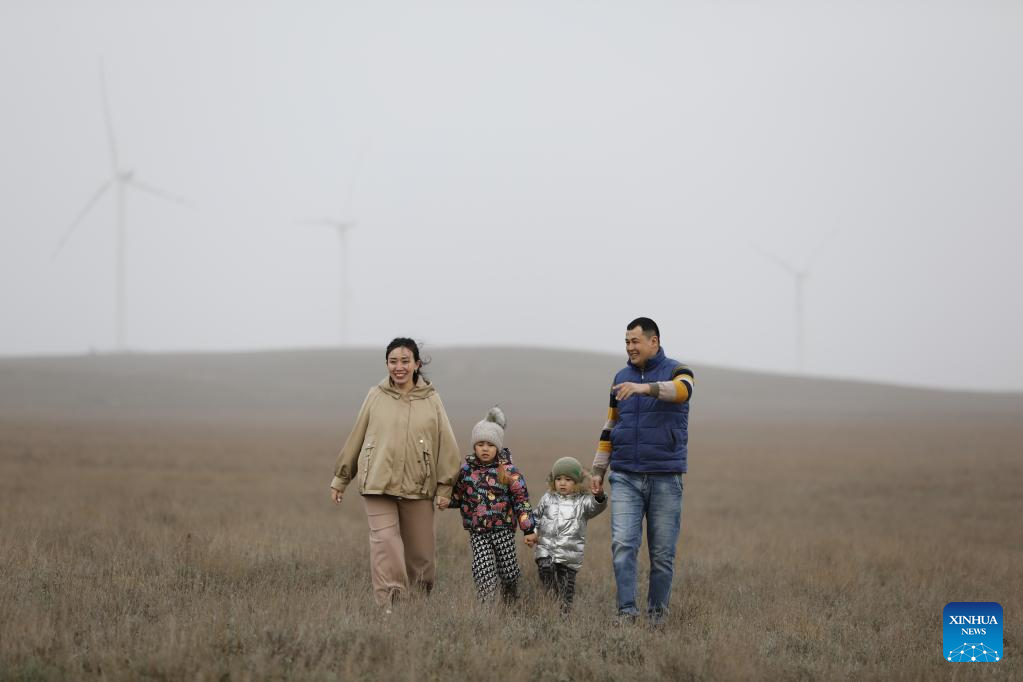
Maksat Abilgaziev (1st R) and his family take a walk on grassland in Zhanatas, Kazakhstan, on April 3, 2023. China and Kazakhstan are pioneers in production capacity and investment cooperation, under the framework of the synergy between the Belt and Road Initiative and Kazakhstan's "Bright Road" new economic policy. The cooperation list includes 52 projects worth a total of more than 21.2 billion U.S. dollars.
The 100-MW Zhanatas wind farm is one of the first batch of key energy projects under the China-Kazakhstan production capacity cooperation framework.
The project was put into operation in June 2021, becoming Central Asia's largest wind farm at that time, greatly alleviating the power shortage in southern Kazakhstan.
Maksat Abilgaziev, a resident of Zhanatas, had been an electrical engineer at a local phosphate mine company. He said he was impressed by the turbine, as its 60-meter-long blade covers an area as big as the London Eye observation wheel, adding that the wind blows in his hometown most of the year. He believed the future of his homeland and Kazakhstan lies in clean energy, especially wind energy. So in 2020, the 30-year-old man decided to step out of his comfort zone and embrace "the future." He then became a trainee responsible for maintaining and repairing wind turbines at the Zhanatas wind farm and learned related maintenance work from Chinese experts.
This year is the third year for Abilgaziev to work at the wind farm. Diligence and studiousness has made the Kazakh man a senior maintenance engineer. "I have a stable job and my life has become better," he said. He and his pregnant wife are looking forward to the fifth member of their family.
The wind power project has created jobs and increased tax revenue for his hometown, bringing new opportunities for urban development, said Abilgaziev.
Talking about the prospect of green energy cooperation between China and Central Asia, Abilgaziev said he was confident that the sky will be bluer, the water cleaner and that human beings will live on a more beautiful Earth in the future. (Photo by Kalizhan Ospanov/Xinhua)

Maksat Abilgaziev (back) works at the central control room of a wind power project in Zhanatas, Kazakhstan, on April 3, 2023. China and Kazakhstan are pioneers in production capacity and investment cooperation, under the framework of the synergy between the Belt and Road Initiative and Kazakhstan's "Bright Road" new economic policy. The cooperation list includes 52 projects worth a total of more than 21.2 billion U.S. dollars.
The 100-MW Zhanatas wind farm is one of the first batch of key energy projects under the China-Kazakhstan production capacity cooperation framework.
The project was put into operation in June 2021, becoming Central Asia's largest wind farm at that time, greatly alleviating the power shortage in southern Kazakhstan.
Maksat Abilgaziev, a resident of Zhanatas, had been an electrical engineer at a local phosphate mine company. He said he was impressed by the turbine, as its 60-meter-long blade covers an area as big as the London Eye observation wheel, adding that the wind blows in his hometown most of the year. He believed the future of his homeland and Kazakhstan lies in clean energy, especially wind energy. So in 2020, the 30-year-old man decided to step out of his comfort zone and embrace "the future." He then became a trainee responsible for maintaining and repairing wind turbines at the Zhanatas wind farm and learned related maintenance work from Chinese experts.
This year is the third year for Abilgaziev to work at the wind farm. Diligence and studiousness has made the Kazakh man a senior maintenance engineer. "I have a stable job and my life has become better," he said. He and his pregnant wife are looking forward to the fifth member of their family.
The wind power project has created jobs and increased tax revenue for his hometown, bringing new opportunities for urban development, said Abilgaziev.
Talking about the prospect of green energy cooperation between China and Central Asia, Abilgaziev said he was confident that the sky will be bluer, the water cleaner and that human beings will live on a more beautiful Earth in the future. (Photo by Kalizhan Ospanov/Xinhua)
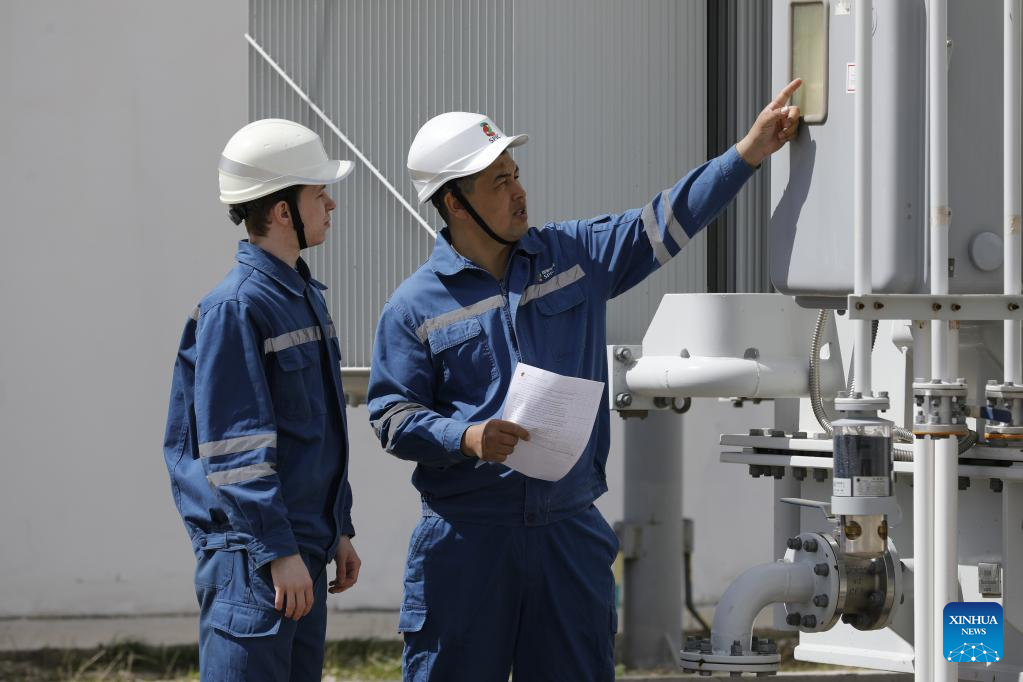
Maksat Abilgaziev (R) and his colleague check power transformer equipment at Zhanatas wind farm in Zhanatas, Kazakhstan, on April 3, 2023. China and Kazakhstan are pioneers in production capacity and investment cooperation, under the framework of the synergy between the Belt and Road Initiative and Kazakhstan's "Bright Road" new economic policy. The cooperation list includes 52 projects worth a total of more than 21.2 billion U.S. dollars.
The 100-MW Zhanatas wind farm is one of the first batch of key energy projects under the China-Kazakhstan production capacity cooperation framework.
The project was put into operation in June 2021, becoming Central Asia's largest wind farm at that time, greatly alleviating the power shortage in southern Kazakhstan.
Maksat Abilgaziev, a resident of Zhanatas, had been an electrical engineer at a local phosphate mine company. He said he was impressed by the turbine, as its 60-meter-long blade covers an area as big as the London Eye observation wheel, adding that the wind blows in his hometown most of the year. He believed the future of his homeland and Kazakhstan lies in clean energy, especially wind energy. So in 2020, the 30-year-old man decided to step out of his comfort zone and embrace "the future." He then became a trainee responsible for maintaining and repairing wind turbines at the Zhanatas wind farm and learned related maintenance work from Chinese experts.
This year is the third year for Abilgaziev to work at the wind farm. Diligence and studiousness has made the Kazakh man a senior maintenance engineer. "I have a stable job and my life has become better," he said. He and his pregnant wife are looking forward to the fifth member of their family.
The wind power project has created jobs and increased tax revenue for his hometown, bringing new opportunities for urban development, said Abilgaziev.
Talking about the prospect of green energy cooperation between China and Central Asia, Abilgaziev said he was confident that the sky will be bluer, the water cleaner and that human beings will live on a more beautiful Earth in the future. (Photo by Kalizhan Ospanov/Xinhua)

Maksat Abilgaziev (back) works at the central control room of a wind power project in Zhanatas, Kazakhstan, on April 3, 2023. China and Kazakhstan are pioneers in production capacity and investment cooperation, under the framework of the synergy between the Belt and Road Initiative and Kazakhstan's "Bright Road" new economic policy. The cooperation list includes 52 projects worth a total of more than 21.2 billion U.S. dollars.
The 100-MW Zhanatas wind farm is one of the first batch of key energy projects under the China-Kazakhstan production capacity cooperation framework.
The project was put into operation in June 2021, becoming Central Asia's largest wind farm at that time, greatly alleviating the power shortage in southern Kazakhstan.
Maksat Abilgaziev, a resident of Zhanatas, had been an electrical engineer at a local phosphate mine company. He said he was impressed by the turbine, as its 60-meter-long blade covers an area as big as the London Eye observation wheel, adding that the wind blows in his hometown most of the year. He believed the future of his homeland and Kazakhstan lies in clean energy, especially wind energy. So in 2020, the 30-year-old man decided to step out of his comfort zone and embrace "the future." He then became a trainee responsible for maintaining and repairing wind turbines at the Zhanatas wind farm and learned related maintenance work from Chinese experts.
This year is the third year for Abilgaziev to work at the wind farm. Diligence and studiousness has made the Kazakh man a senior maintenance engineer. "I have a stable job and my life has become better," he said. He and his pregnant wife are looking forward to the fifth member of their family.
The wind power project has created jobs and increased tax revenue for his hometown, bringing new opportunities for urban development, said Abilgaziev.
Talking about the prospect of green energy cooperation between China and Central Asia, Abilgaziev said he was confident that the sky will be bluer, the water cleaner and that human beings will live on a more beautiful Earth in the future. (Photo by Kalizhan Ospanov/Xinhua)

Maksat Abilgaziev (L) interacts with his pregnant wife at his residence in Zhanatas, Kazakhstan, on April 3, 2023. China and Kazakhstan are pioneers in production capacity and investment cooperation, under the framework of the synergy between the Belt and Road Initiative and Kazakhstan's "Bright Road" new economic policy. The cooperation list includes 52 projects worth a total of more than 21.2 billion U.S. dollars.
The 100-MW Zhanatas wind farm is one of the first batch of key energy projects under the China-Kazakhstan production capacity cooperation framework.
The project was put into operation in June 2021, becoming Central Asia's largest wind farm at that time, greatly alleviating the power shortage in southern Kazakhstan.
Maksat Abilgaziev, a resident of Zhanatas, had been an electrical engineer at a local phosphate mine company. He said he was impressed by the turbine, as its 60-meter-long blade covers an area as big as the London Eye observation wheel, adding that the wind blows in his hometown most of the year. He believed the future of his homeland and Kazakhstan lies in clean energy, especially wind energy. So in 2020, the 30-year-old man decided to step out of his comfort zone and embrace "the future." He then became a trainee responsible for maintaining and repairing wind turbines at the Zhanatas wind farm and learned related maintenance work from Chinese experts.
This year is the third year for Abilgaziev to work at the wind farm. Diligence and studiousness has made the Kazakh man a senior maintenance engineer. "I have a stable job and my life has become better," he said. He and his pregnant wife are looking forward to the fifth member of their family.
The wind power project has created jobs and increased tax revenue for his hometown, bringing new opportunities for urban development, said Abilgaziev.
Talking about the prospect of green energy cooperation between China and Central Asia, Abilgaziev said he was confident that the sky will be bluer, the water cleaner and that human beings will live on a more beautiful Earth in the future. (Photo by Kalizhan Ospanov/Xinhua)



